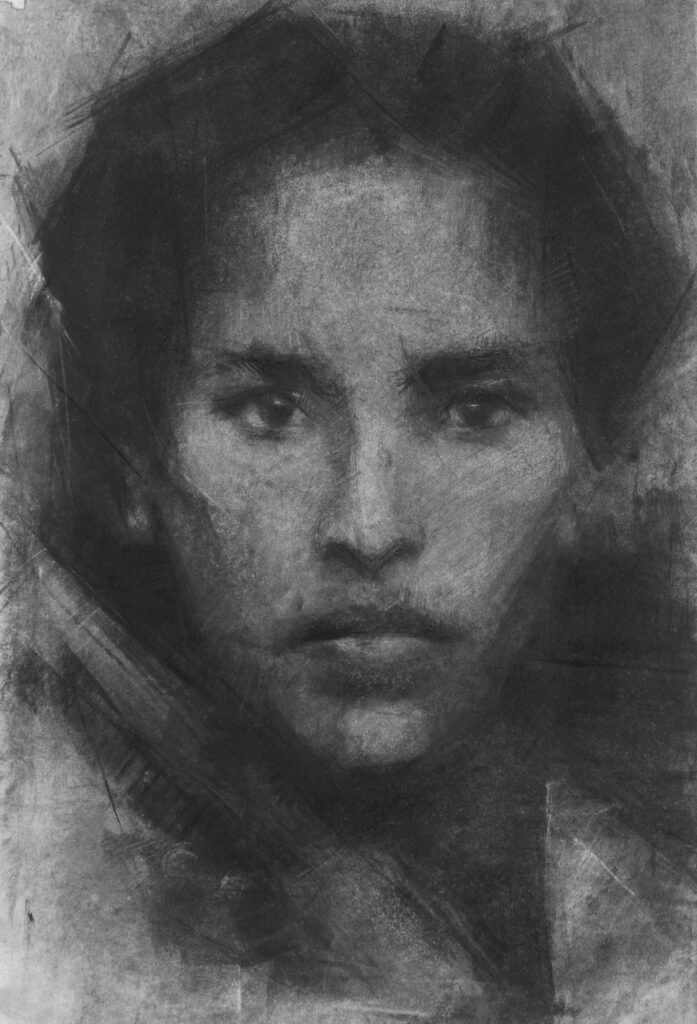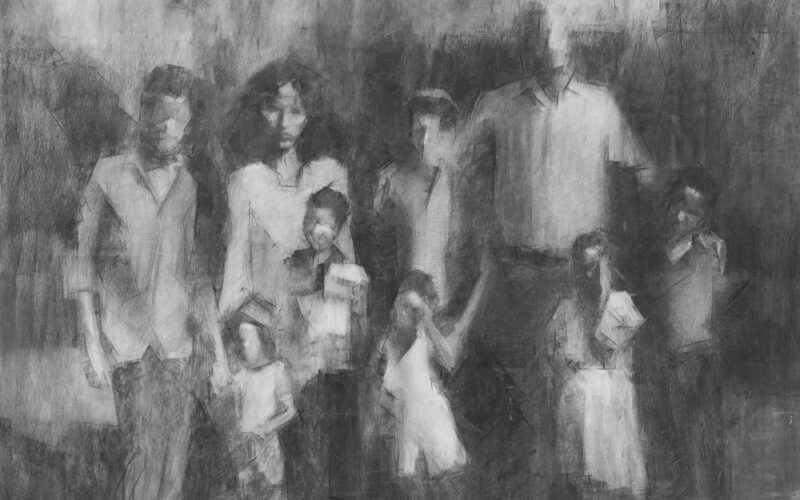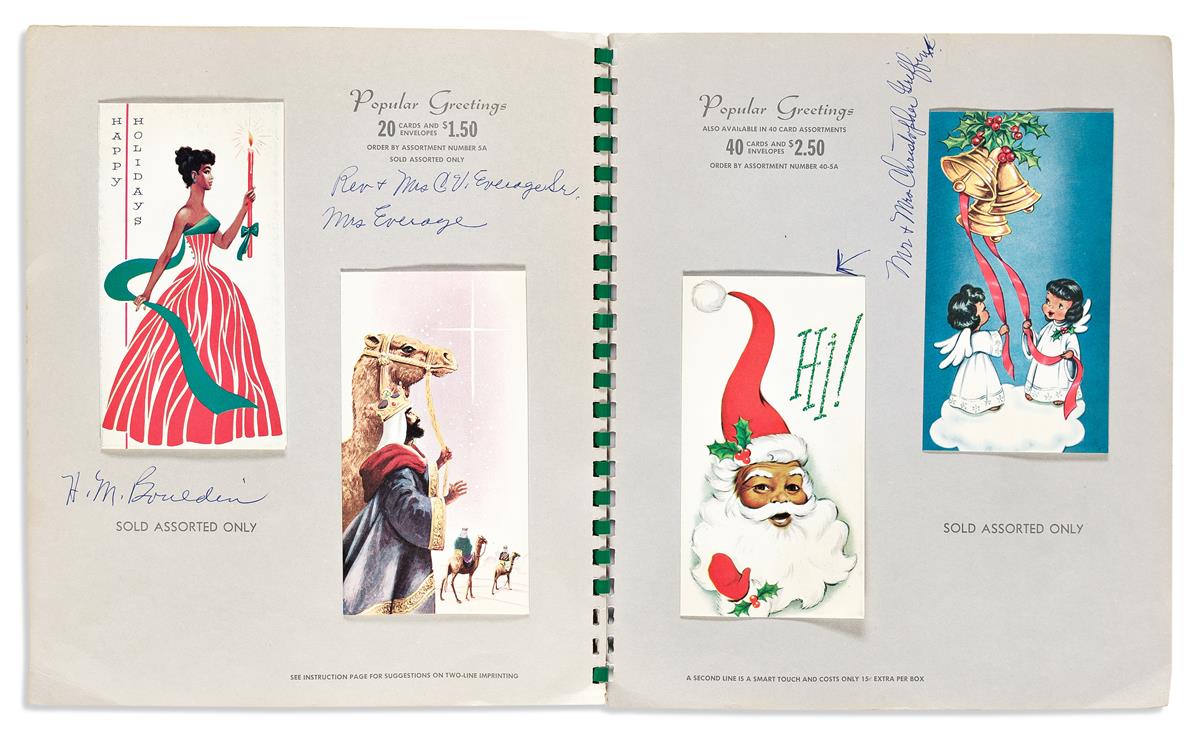Born in Ethiopia, Tigist Yoseph Ron (born 1977) came to Israel with her family during Operation Moses in the mid-1980s—and that sense of movement is apparent in the striking charcoal drawings she produces today. Already creating a legacy akin to that of the late Charles White and his first wife, Elizabeth Catlett, Ron casts a softness over her subjects, unveiling the emotions behind displacement. Her charcoal drawings—always in black and white—tell visual stories, touching on themes such as motherhood, femininity and ostracism, which bring to life seemingly mundane activities like convening on the couch (Afternoon (2022)), or spending quality time with a beloved pet (Itay (2022)) or preparing fresh ingredients in the kitchen (Frying (2020)).
With quick yet realistic strokes, the artist begins each drawing with a subject with whom she is close, obscuring the individual’s identity in most cases by evoking a sense of movement or rhythm. Ron applies light and shadow to her drawings with the utmost care, blending shapes and forms to convey not only power, but vulnerability.
Putting Ron in conversation with White and Catlett, the viewer must acknowledge that Ron is above all a storyteller. As White once stated, “Art must be an integral part of the struggle. It can’t simply mirror what’s taking place … It must ally itself with the forces of liberation.” The artist referred to his own work as “images of dignity,” where he chronicled the triumphs and challenges of African American subjects—cementing his reputation as one of the most celebrated artists in African American art history.

Charcoal on paper
29×21 cm
Courtesy of the artist
Photographer: Elad Sarig
Ron achieves the same thing for Israel’s expansive population of Ethiopian Jews. In representational form, she chronicles her subjects living their daily lives, posing questions about identity and self-discovery as she illustrates the impact of immigration from Ethiopia to Israel. Placing her subjects in home settings, Ron illuminates the challenges immigrants face in adapting to a new culture, assimilating into a foreign society, and sacrificing the comfort of home for what could amount to a better world.
But at what cost? What are the social attitudes to which these immigrants must adapt? What is the price a person must pay to leave their life behind and start anew? These are the questions Ron asks her Ethiopian Jewish peers in Israel throughout her work—similar to those White and Catlett asked their audiences about the Black American experience in the mid-20th century. Catlett shed light on the female experience, just as Ron does in her drawings: using her entire body to create, infusing a sense of physicality into the work to make it more natural, more human.
The viewer experiences a similar sense of motion, following Ron’s charcoal lines that guide the eye through the drawing, crafting an abstract rhythm that builds connection. There’s a deep intimacy inherent in viewing Ron’s drawings as one observes the subjects at home in contemplation.

Tigist Yoseph Ron, Home with Tatey, 2022
54×91 cm
Charcoal on paper
Courtesy of a Private Collection
In much of her work, Ron explores her relationship with her mother, who died when Ron was a teenager. She observes adult women as they live their lives unobserved and unobstructed, shedding light on the unique social attitudes that sustain them. Catlett, known for her sculptures and prints, explored similar themes—among them racism, classism and identity. Both artists create a palpable combination of both vulnerability and strength, of both feeling at home and feeling like an outsider.
And with her subjects’ facial features blurred, it is easy for viewers to place themselves in these women’s position—to wonder, what if that were me? These subjects could be anyone, although in some cases, Ron offers a more personalized take. Atlit (2019), for instance, is admittedly based on a photograph captured after the artist’s family immigrated to Israel; Ron and her relatives are the nine subjects, their features abstract but their collective stance empowered. The artist’s strokes are rapid and precise, designed to freeze-frame a moment in time that isn’t quite in focus but is vivid in its exactness. In rare instances, Ron incorporates more detail into her subjects’ well-defined features in works such as Fray (2018) and Hirut (2018), capturing stillness while preserving the rhythm of her artistic hand.
A graduate of Bezalel Academy of Art and Design in Jerusalem, Israel, Ron received the Haim Shiff Prize for Figurative Realist Art in 2019, which included a solo show at the Tel Aviv Museum of Art in 2020. Currently, Ron is preparing for a collaboration with the Jerusalem Print Workshop, in which she will create a series of works, with the workshop providing all the materials she will need, along with a designated workspace and teaching assistance. Following in Catlett’s footsteps, the prints will continue to shed light on the Black-female identity.
Ron lays a strong foundation for artists of color in Israel—bringing some of the most essential voices to the forefront of the nation’s sociopolitical discourse.











